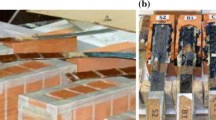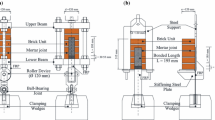Abstract
The paper presents comparison of a work of stiff and flexible bonds fastening composite strengthening to masonry. In the first approach (traditional), barely deformable interface material made of stiff epoxy resin is used as shear bonds of composites-to-brick. In the second one (innovative), highly deformable interface material made of flexible polymer is used as repair shear bonds of composites-to-brick. Behavior of both materials was compared using single-lap shear tests made on four kinds of fiber fabrics (glass, carbon, basalt and steel) applied to clay brick units. The results indicated that highly deformable interface materials allow increasing load capacity, because deformable adhesive layers reduce shear stress concentrations in bond, redistributing stress more evenly along the whole lap joint. Usefulness of the theory which allows calculating the bond shear stress–slip characteristic was also discussed in accordance to the highly deformable interface materials.













Similar content being viewed by others
References
Accardi M, La Mendola L (2004) Stress transfer at the interface of bonded joints between FRP and calcarenite natural stone. In: Proceedings of the 4th international conference on structural analysis of historical construction—SAHC 2004. Padova, Italy
Buyukozturk O, Gunes O, Karaca E (2004) Progress on understanding debonding problems in reinforced concrete and steel members strengthened using FRP composites. Constr Build Mater 18:9–19
Camli US, Binici B (2007) Strength of carbon fiber reinforced polymers bonded to concrete and masonry. Constr Build Mater 21:1431–1446
Celestini G, Casadei P (2009) Innovation on advanced composite materials for strengthening and protection of historical masonry structures. In: Proceedings of 3rd confernce on mechanics of masonry structures strengthened with composite materials: modeling, testing, design, control—MuRiCo3. Venice, Italy, pp 184–191
Corradi M, Grazini A, Borri A (2007) Confinement of brick masonry columns with CFRP materials. Compos Sci Technol 67(9):1772–1783
Croci G, Viskovic A (2000) L’uso degli FRP di fibra aramidica per il rinforzo della Basilica di San Francesco di Assisi. In: Proceedings of mechanics of masonry structures strengthened with FRP materials. Venezia, Italy
Dantu P (1957) I—Research on the environmental constrains in heterogeneous application to concrete. (in French) Laboratoire Central des Ponts et Chaussées. Publication No. 57-6, Paris, France
Derkowski W, Kwiecień A, Zając B (2013) CFRP strengthening of bent RC elements using stiff and flexible adhesives. Technical transactions 1-B/2013, pp 37–52
Fitton MD, Broughton JG (2005) Variable modulus adhesives: an approach to optimized joint performance. Int J Adhes Adhes 25:329–336
Flaga K, Kwiecień A (2010) Efficiency of CFRP strengthening of arches tested by failure of historical building after the inappropriate repair intervention. Adv Mater Res 133–134:837–842
Jasieńko J, Bednarz Ł, Nowak T (2009) The effectiveness of strengthening historic brick vaults by contemporary methods. In: Mazzolani FM (ed) Protection of historical buildings, PROHITECH’ 09. Taylor and Francis, Rome, pp 1299–1304
Kubica J, Kwiecień A, Zając B (2008) Repair and strengthening by use of superficial fixed laminates of cracked masonry walls sheared horizontally—laboratory tests. In: AIP Conference Proceedings 1020:1546. doi: 10.1063/1.2963782, Proceedings of Seismic Engineering International Conference MERCEA’08. Villa San Giovanni Reggio Calabria, Italy, pp 1546–1553
Kwiecień A (2009) Flexible polymers using in repair of cracked masonry walls as a composite material. In: Proceedings of 3rd conference on mechanics of masonry structures strengthened with composite materials: modelling, testing, design, control—MuRiCo3. Venice, Italy, pp 325–332
Kwiecień A (2009) Polymer flexible joint—an innovative repair system protecting cracked masonries against stress concentrations. In: Mazzolani FM (ed) Protection of historical buildings, PROHITECH’ 09. Taylor and Francis, Rome, pp 1033–1038
Kwiecień A (2012) Stiff and flexible adhesives bonding CFRP to masonry substrates—investigated in pull-off test and Single-Lap test. Arch Civ Mech Eng 12(2):228–239
Kwiecień A, Zając B, Kuboń P (2012) Post failure repair of strengthening system made of CFRP and GFRP strips bonded to brick substrate—examined in single-lap tests. In: Proceedings 6th international conference on FRP composites in civil engineering CICE’ 2012, Rome, Italy
Łagoda M (2005) External bonded reinforcement in bridge strengthening (in Polish). Monograph 322, Cracow University of Technology, Cracow, Poland
Micelli F, De Lorenzis L, La Tegola A (2004) FRP-confined masonry columns under axial loads: experimental results and analytical model. Mason Int 17(3):95–108
Modena C (2004) Design approaches of investigations for the safety and conservation of historic buildings. In: Proceedings of the 4th international conference on structural analysis of historical construction—SAHC 2004. Padova, Italy
Oliveira DV, Basilio I, Lourenço PB (2010) Experimental behavior of FRP strengthened masonry arches. ASCE J Compos Constr 14(3):312–322
Panizza M, Garbin E, Valluzzi MR, Modena C (2008) Bond behaviour of CFRP and GFRP laminates on brick masonry. In: Structural analysis of historic construction—SAHC08. Bath, UK, pp 763–770
Rivlin RS (1948) Large elastic deformations of isotropic materials. II Some uniqueness theorems for pure homogenous deformation. Philos Trans R Soc Lond Ser A 240:491–508
Valluzzi MR, Oliveira D, Caratelli A, Castori G, Corradi M, de Felice G, Garbin E, Garcia D, Garmendia L, Grande E, Ianniruberto U, Kwiecień A, Leone M, Lignola GP, Lourenço PB, Malena M, Micelli F, Panizza M, Papanicolaou CG, Prota A, Sacco E, Triantafillou TC, Viskovic A, Zając B, Zuccarino G (2012) Round robin test for composite-to-brick shear bond characterization. Mater Struct 45:1761–1791
Valluzzi MR, Tinazzi D, Modena C (2002) Shear behavior of masonry panels strengthened by FRP laminates. Constr Build Mater 16(7):409–416
Valluzzi, Valdemarca M, Modena C (2001) Behavior of brick masonry vaults strengthened by FRP laminates. ASCE J Compos Constr 5(3):163–169
Acknowledgments
The author would like to thank Bogusław Zając for his help in preparing specimens with the highly deformed adhesive and Piotr Kuboń for his help in numerical calculations. I am particularly grateful to SIKA Poland for their support in the experimental activity and to Italian companies: Fidia Technical Global Service and SGM Laboratory, Perugia (Italy), for the provision of composite materials and for availability of facilities for making specimens, respectively and SanMarco-Terreal Italian, Noale (Venice, Italy) for providing the bricks.
Author information
Authors and Affiliations
Corresponding author
Rights and permissions
About this article
Cite this article
Kwiecień, A. Shear bond of composites-to-brick applied with highly deformable, in relation to resin epoxy, interface materials. Mater Struct 47, 2005–2020 (2014). https://doi.org/10.1617/s11527-014-0363-y
Received:
Accepted:
Published:
Issue Date:
DOI: https://doi.org/10.1617/s11527-014-0363-y




